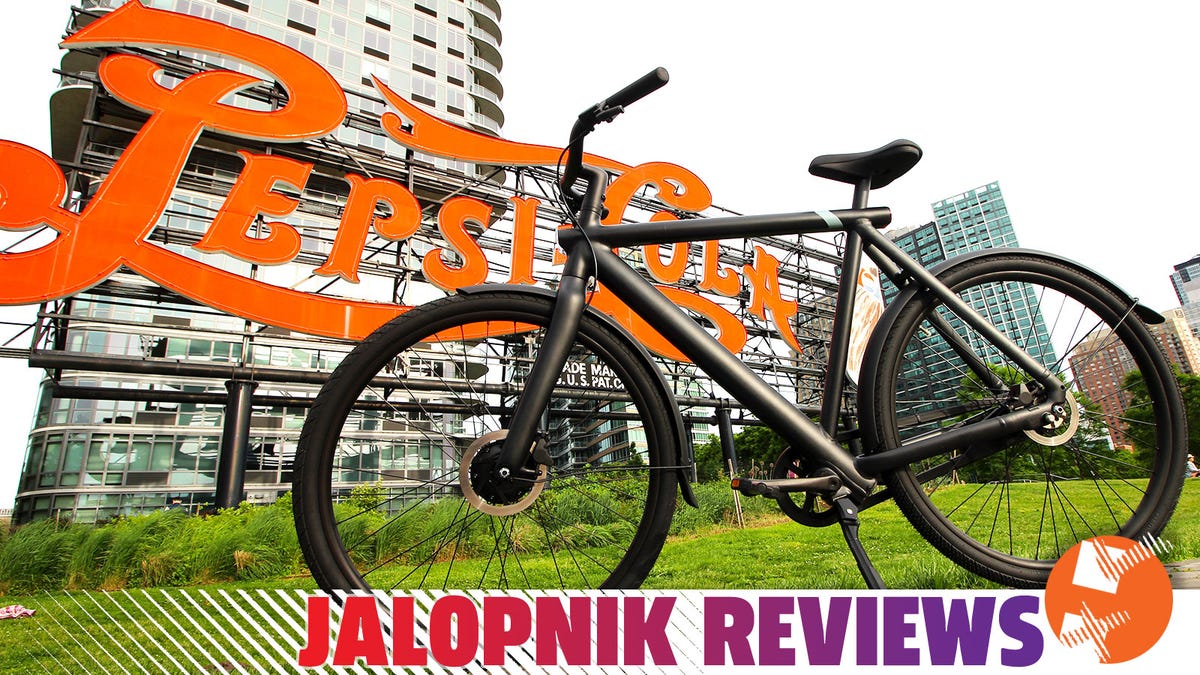The VanMoof S3 Is Great, Even if Our Garbage Roads Aren't

Photo: Owen Bellwood
I love cycling around cities. When you’re new to a place, it’s a great way to get your bearings, and you can discover much more about the city than you would taking a train. For me, a recent New York City transplant, this has meant turning to a trusty road bike with narrow tires and dropped handlebars to get from A to B. But after a week riding the VanMoof S3 electric bike, I think I could be converted to this battery-powered way of life. Well, if NYC can fix one small issue first.
(Full Disclosure: VanMoof lent me one of its very chic S3 e-bikes for a week, with a full battery and free rein to ride it wherever and however I pleased.)
There’s no denying that the VanMoof S3 is a good looking bike. Photo: Owen Bellwood
What the Heck is a VanMoof?
VanMoof is a bike maker from the Netherlands that currently offers two models of e-bike. The X3 features a step-through design, while the S3 I sampled has a more traditional look, and is designed for taller riders.
Both bikes look pretty sleek, but this S3 is a real head-turner. It even sparked compliments from people on the street, in the freight elevator up to our office and from my fellow Jalops.
Looks aside, they each feature the same 90-mile range and 20mph top speed, which is handled by the same single-motor setup. Every VanMoof has a 350W motor fitted inside the front wheel, which aids weight distribution as the fully-integrated, four-speed automatic gearbox is at the back.
The VanMoof S3 has a fully enclosed automatic gearbox at the rear. Photo: Owen Bellwood
And what about that gearbox? Well, it’s fully enclosed along with a traditional bike chain and features four gears paired with an electric shifter. Out the box, you can use two pre-programmed gear modes, flat and hilly, as well as a manual shift setting or a custom option. In flat, the gear changes are more evenly spread out while the hilly option changes up the gears at a slightly higher speeds, making pedaling easier when you can’t go quite so fast up an incline. In custom, you set the speeds at which your bike will automatically shift up or down.
On the frame, VanMoof’s integrated front and rear lights protrude from the top tube, which also houses the battery pack. The bike does a great job of hiding all its electric-ness in this chic package. It’s also quite big, dwarfing my 1970s road bike. I was able to fit it in my diminutive apartment, but at 46 pounds, lugging it up a narrow staircase wasn’t ideal.
All the bike’s settings can be controlled via the app. Graphic: Owen Bellwood
But before we haul it up any more stairs, we need to talk about the setup. After plugging the bike in for four hours to establish a full charge, you turn to your phone and VanMoof’s app to set things up. There, you can check for software updates, name your new steed (I called mine Dave) and get ready for your first ride.
To do this, you’ve got a host of settings to chose from. There are four levels of pedal assist, and you can choose between those gearshift settings. Through the app, you can also control the built-in lights, choose the sound of the electronic “bell” and set up the bike’s built-in security system.
It’s these security features that VanMoof often touts as the bike’s big selling point. The S3 has a built-in kick lock that halts the rear wheel; when this is engaged, an alarm will sound if someone tries to move the bike. It’s a really simple system and I found myself engaging it every time I stopped. Way less hassle than a conventional chain or U-lock.
That little silver button is the kick lock that disables your back wheel. Photo: Owen Bellwood
And that meant I got a chance to test out that alarm. It comes on whenever the locked bike is knocked or shaken aggressively, with a loud swooshing and beeping noise and a skull flashing on the built-in dot-matrix display on the top tube. That’s right, the bike has a small display in the frame that acts as your battery indicator, speedometer and thief deterrent.
The bike’s dot-matrix display shows you when it’s locked. Photo: Owen Bellwood
If the alarm is triggered, you also get a notification to your phone, as well as an email. You unlock the bike via the phone or smartwatch app, or by pressing the bell button in the unique combination pattern you set when you first set-up the bike. It’s all very neat.
That’s Great, But How Does it Ride?
Honestly, it’s lovely.
The riding position is quite upright, which I liked, and the slightly swept-back handlebars are super comfortable. They also give you a good sense of balance and control, and remain pretty grippy even when you’re caught in a sudden monsoon, like I was.
It’s a pedal-assist bike, so once you’ve selected your level of assistance, you set off and the bike does most of the rest. I spent the majority of my time with the VanMoof in assist level two or three, which give a nice boost of power when you need it on hills but still feels like you’re actually putting a bit of effort into your ride. Setting one feels a bit too much like hard work (this is not a light bike!), and setting four makes cycling a little too easy.
The front wheel motor can power you up to 20 mph. Photo: Owen Bellwood
Setting off from a stop, the bike quickly ramps up to full speed. In “flat” gear-change mode (which I used for the majority of my riding), there’s an upshift around 6 mph, another at 12 mph and the final change up is at 15 mph. Each one is mostly seamless, but there were times when I shot up to full-speed a little too quickly for the bike to keep up. On those occasions, easing off the pedals for a sec allowed the automatic shifter to catch up.
Manual shifting took a bit of getting used to, but as with everything on this bike, once you’ve got the technique down it runs like clockwork. To upshift, you double tap the Turbo Boost button (more on that later); two-tap it while holding down the bell button for a downshift. I was a bit worried this might lead to a lot of unnecessary bell-ringing, but it worked flawlessly.
It was nice having this extra level of control over my speed and pedaling, but I do wish there was a way to stay in automatic but allow a manual shift override here and there, like you’ve got with most modern automatic cars. Because sometimes, usually on a hill, it would be nice to shift up or down as you want.
Everything should come with a Turbo Boost button. Photo: Owen Bellwood
Tell Me More About This Turbo Boost?
Well, Turbo Boost is a button you press to give yourself an extra jolt of power. When you press it, you’ll accelerate up to the bike’s 20-mph top speed pretty quickly.
I found myself using Turbo Boost the most on steep hills and the long inclined portion of the bridges between Manhattan and Brooklyn. Using it will eat away at your range, however, and VanMoof says that heavy boosting and higher assistance levels will put your range down to about 40 miles.
Personally, I found that after seven miles of riding around on level three assist, plus a lot of boosting, I’d used up around 10 percent of my battery, which seems alright.
If your bike can Turbo-Boost itself to 20 mph, you’ll probably want it to come to a halt safely. The VanMoof sports a pair of hydraulic disc brakes, which did a fine job of repeatedly stopping all this mass and speed.
Is There Anything Wrong With the S3?
There is one glaring negative with the VanMoof S3, especially if you’re someone who might live in a place like NYC and ride crumbling city streets on the regular: It doesn’t have any form of suspension.
If you go online and order a VanMoof S3 right now, it’ll set you back $2,448 plus tax and delivery. For New Yorkers, that brings the total to $2,731, potentially more for customers elsewhere. And while that isn’t an extreme price in the world of electric bikes, it’s still quite a lot to spend on a mode of transport that won’t offer any isolation from bumps and ruts. Even mild pavement imperfections shake your bones – especially at 20mph! As someone who rides a skinny-tire road bike everywhere, I’m no stranger to dodging potholes, cobblestones, or the odd abandoned trolley track poking through seven layers of indifferently-applied pavement. That’s a sacrifice I’m willing to make on my Craigslist beater 12-speed, but at the S3’s price, and with its leisurely cruiser geometry, it’s harder to swallow. There is a new VanMoof e-bike coming that will offer full suspension, but that model is anticipated to add $1,000 to the price of the bike I rode.
Also, the S3 is big. I’m six-foot and had the saddle adjusted pretty low, while my 5′ 8″ partner found the bike a bit too big for her to ride, no matter how we adjusted things. VanMoof does offer the X3 for anyone seeking this drivetrain in a smaller frame, but it just doesn’t look quite as cool.
And while we’re talking negatives, this is a small one, but I’d like to have more color options than just black or pale blue.
You can get your S3 in black with a blue stripe, or blue with a black stripe. Photo: Owen Bellwood
Could You Live With the VanMoof S3?
Honestly, yes. Living with the VanMoof for a week was a lovely affair.
It cut my commute time in half, and because I knew I wouldn’t arrive a hot mess, I was much happier to ride to work and just about everywhere else I went that week. The built-in lights meant one less thing to remember when packing my bag in the morning. And the electric bell is great at alerting every pedestrian who steps out into a bike lane without looking.
It’s a very pretty bike, isn’t it? Photo: Owen Bellwood
As a complete package, the VanMoof S3 is an excellent proposition. If it comes undone, it’s not through any fault of the design, but rather a matter of the place you live.
Having cycled the length of the Netherlands, I’m sure that this bike is perfect for that nation’s beautifully smooth bike lanes and ample infrastructure for secure bike storage.
Here in New York City, that isn’t the case. The city has been adding bike lanes to neighborhoods for years, but they’re rather unevenly distributed, and only a small portion of them are protected. Like our roads, our bike lanes often have crappy paving, and cars and trucks often park directly in the path with zero apparent repercussion from parking enforcement.
In the frame, there are front and rear lights that come on whenever you power up. Photo: Owen Bellwood
Then, there’s the struggle of finding a place to lock your bike at your destination. In the Netherlands, VanMoof’s home, enormous bicycle garages are dotted around every city. Here in the greatest city in the world, you’re lucky if you can find one solitary bike stand on a city block. And I don’t think I trust the built-in security quite enough to just leave the S3 out on the sidewalk.
Because of this, I had to go through the whole ordeal of getting a visitor pass to take my bike inside our office. That’s right, the bike got its own ID sticker. Every morning, I’d sign it in then take a truck elevator down two floors only to take a freight elevator back up another eight. It really added to the joys of cycling to work.
So yes, the VanMoof is a lovely electric bike to ride. The drawbacks I experienced in my week reviewing this bike had more to do with where I live and ride than anything about the bike itself. With bikes as with cars, sometimes a European-market item isn’t a perfect fit for U.S. customers. I’m anxious to try the full-suspension VanMoof when it arrives. If it’s as good as the S3, plus more comfortable on my crappy roads, it could be a knockout.




